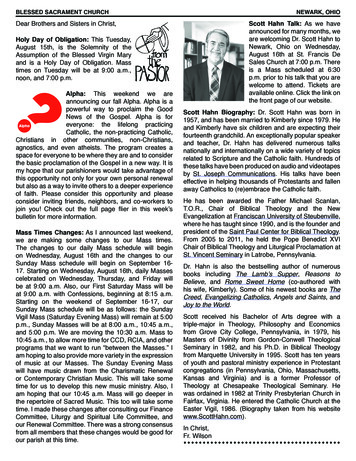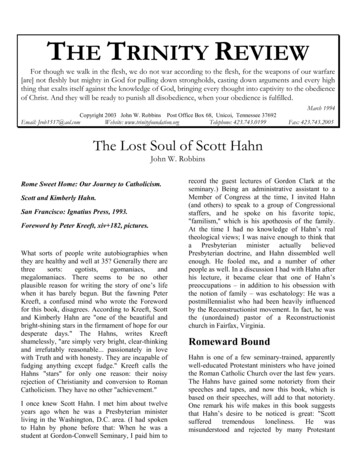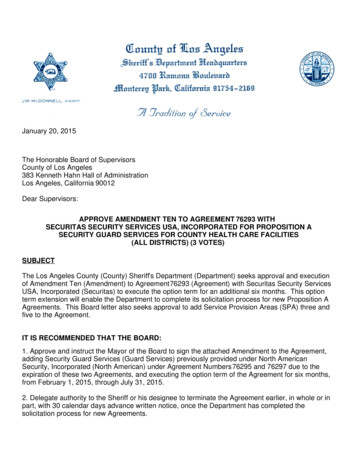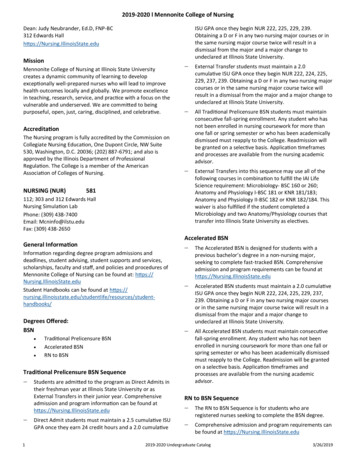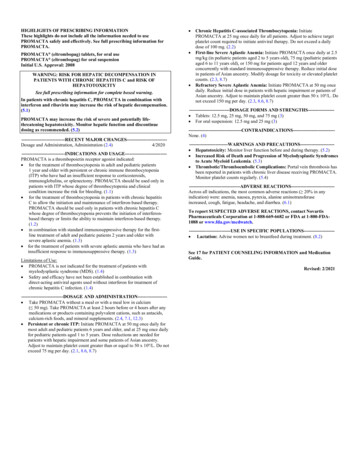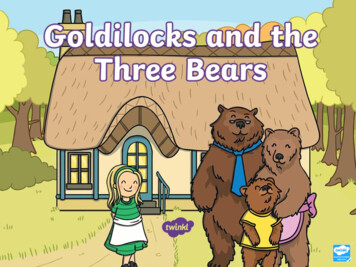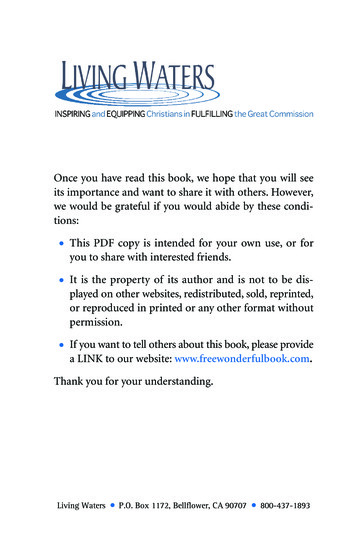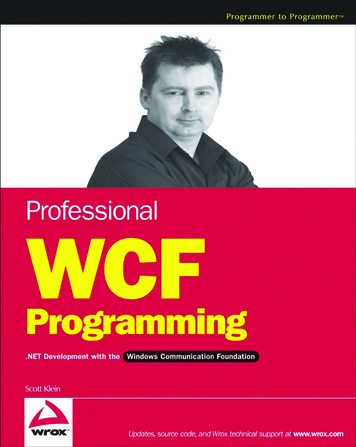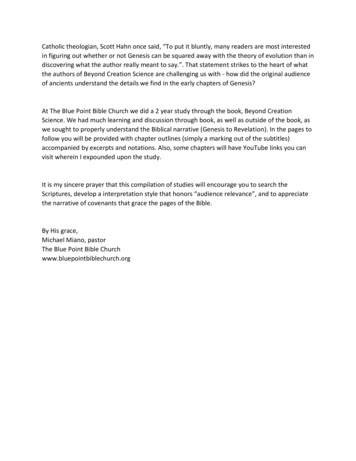
Transcription
Catholic theologian, Scott Hahn once said, “To put it bluntly, many readers are most interestedin figuring out whether or not Genesis can be squared away with the theory of evolution than indiscovering what the author really meant to say.”. That statement strikes to the heart of whatthe authors of Beyond Creation Science are challenging us with - how did the original audienceof ancients understand the details we find in the early chapters of Genesis?At The Blue Point Bible Church we did a 2 year study through the book, Beyond CreationScience. We had much learning and discussion through book, as well as outside of the book, aswe sought to properly understand the Biblical narrative (Genesis to Revelation). In the pages tofollow you will be provided with chapter outlines (simply a marking out of the subtitles)accompanied by excerpts and notations. Also, some chapters will have YouTube links you canvisit wherein I expounded upon the study.It is my sincere prayer that this compilation of studies will encourage you to search theScriptures, develop a interpretation style that honors “audience relevance”, and to appreciatethe narrative of covenants that grace the pages of the Bible.By His grace,Michael Miano, pastorThe Blue Point Bible Churchwww.bluepointbiblechurch.org
BCS IntroductionCould you relate to Normas Voss’s introductory story? How so?“The inability of Christians to grasp the meaning and message of both Genesis and Revelationcreate a great divide in America. Christians struggle with both the beginning and theculmination of the Scripture – the Alpha and the Omega as they might be called. Both Genesisand Revelation bring a lot of baggage with them to the American religious scene”– How have you personally seen this as true?“You hold in your hands a book that offers a full picture of both ends of the story the Bibletells. You hold in your hands a book that brings together the story of origins with the story ofredemption and provides the most complete and comprehensive understanding that I haveever seen in my decades of study”.– What are you hoping to gain out of this study?“conservative Christians in America” (pg. 13)cf. “We believe the Bible can be understood through careful consideration, intelligent inquiry,due diligence, and effort”.You can watch the video review of this study at the following link;https://www.youtube.com/watch?v PnrPlXsXX-4Further study:Links for in- depth study of topics related to BCS & Covenant ation-archiveBlog – Returning To Our First Love – ions/Blog – Responding To Newsweek – Mr. Kurt Eichenwald & Biblical blical-illiteracy
Chapter 1 - What Did Jesus Say?“Some Standing Here Will Not Taste Death Until ”cf. Matthew 16:27-28Peter Was Martyred, But John Lived On!cf. John 20:15-23“This Generation Will Not Pass Away Until All ”cf. Matthew 24:34The Great Tribulation Has Already Happened.Two Debates In One Book“Bible prophecy and Genesis creation, relate to one another across our Bible”.X- millennialism vs. Pan – millennialism“The only way to honor Jesus is to pay close attention to everything He taught”.“Why would the Bible have so much prophecy in it if Christians were not meant to understandit?”You can watch the provided review video at the following link,https://www.youtube.com/watch?v DiLrzW05B9Y
Chapter 2 – Time Is Running OutThe Proper Frame of Reference“It is very easy to forget that our New Testament speaks of real people who lived at a particulartime and place on planet Earth. It is not merely a collection of doctrine and practical truths”.The Disciples Followed The MasterInitial Expectationcf. Acts 2:40Near-ing Expectationcf. James 5:5-9Near-er Expectationcf. Hebrews 10:35-37“It is a symptom of the confusion that dominates current discussion of prophecy that thosewho continue to place the coming of Christ in our future speak of Christ as “tarrying” to ourday, thousands of years later. However, the author of Hebrews plainly says that He who iscoming “will not tarry”.”Near-est Expectationcf. Revelation 1:1, 3, 9, 10-11; 22:6-7, 10-12, 20Revelation: John’s Olivet Discourse“Revelation speaks of things past, things present, and things future in John’s world”.ConclusionHere is a link to the video review for our study through Chapter 2 of Beyond Creation Science,https://www.youtube.com/watch?v VgFq50bZklo&feature youtu.be
Chapter 3 – When Did This Happen?Coming On The Cloudscf. Matthew 26:64; Isaiah 19:1; Nahum 1:3,6,8; Exodus 14:24-25The Right Question“When did this happen?”“The Romans completely demolished the Temple under the direction of General Titus in AD 70,about 40 years after Jesus spoke”.What We Should Expect“What should we expect from Church history if our viewpoint is correct? Jesus warned Hisdisciples to flee (Matt. 24:15-16). If the disciples recognised these events in their day asfulfilment of the Olivet Discourse, then Church history should record the early Christians fleeingJerusalem. Furthermore, if the early Christians acted in obedience to Jesus’ warnings, therewould have been no Christian eyewitnesses to the event because no Christians were present”.Eusebius records the flight to Pella.“The difficulty is that most Christians do not know about the Roman-Jewish War”.Setting The Scene“You decide if history confirms the fulfilment of Jesus’ prophesies”.There Shall be False ProphetsIncrease of Lawlessness & Decadence
There Shall Be Wars & Rumors of WarsFamines & EarthquakesPersecution & DeathThe Abomination of DesolationIf Those Days Had Not Been Cut ShortThe Flood, Sodom, and JerusalemSigns & Wonders
The Destruction of Jerusalem“For eighteen hundred years, these historical events were common knowledge amongChristians. Yet for reasons unknown, the implications were never systematicallyexplored history has largely been forgotten. The purpose of this book is to help reviveknowledge of the past and explore the implications, not just in regard to the conclusion of theBible, but the implications for the beginning as well”.See also, 101 Time Statements - re is the link to the review video done by Pastor Michael Miano for this chapter’s study,https://www.youtube.com/watch?v e348GtoKT3Q
Chapter 4 -The End Of A Covenant WorldThe “Last Days” Of What?“ the last days were a contemporary reality during the New Testament times”.cf. Acts 2:14-17; Hebrews 1:1-2; Jude 17-19; 1 John 2:18, 26“ If the last days were back then, how is it possible that we are still around? Obviously theworld did not end in the first century”. (pg. 70)\The “End” Of What?“ how would devout Jews, who knew their Old Testament well. Understand apostolicreferences to the “end”?” cf. Deuteronomy 32:20; Matthew 24:3; 1 Corinthians 10:11; 1 Peter4:7The Focus of Prophecy“Prophecy is primarily concerned with the redemption of God’s people”.The Elements Will Meltcf. 2 Peter 3:10-12“We must recognize that the Holy Spirit is consistent with His use of words and concepts inScripture. The melting and dissolving of Peter’s “elements” was a total covenantaltransformation, not a cosmic conflagration”. - John Noe
The “Heavens and Earth”“Just as the formation of Israel and giving of the Law was the metaphorical creation of “heavenand earth”, so the destruction of the Judaic society, the Law, the priesthood, and Temple wouldbe the passing away of Israel’s “heaven and earth”.According To His Promisecf. 2 Peter 3:13; Matthew 24:34-35; Matthew 5:17-18Symphonic Unity in Biblical Prophecy“But what we hope to impress upon the reader at this point is that there is an essential unity tothe story the New Testament tells Prophecy communicates like a great symphony”.
Chapter 5 – The Divide: 1830Geology and ChristianityThe Problem for Darwin: GeologyThe Rise of Intelligent DesignLyell – Cornerstone or Capstone of Geology?The Coincidence of Geology and TheologyThe Other Capstone Event of 1830Margaret McDonald’s dream and John Nelson Darby’s pre-trib rapture theoryThe 1830 SynchronicityPre-trib rapture (theology) Lyell’s, Principles of Geology (geology) - a violent collision ofperspectives; created what we know today as theology - science divide.
Chapter 6 – Worlds Collide: Lyell & DarbyThe Liberalism/ Fundamentalism ContextThe Dominant Old Earth View“ the idea of an ancient earth was the dominant if not universal belief among Christians”.- long before DarwinThe Premillennial Source of Flood GeologyCovering the TracksPremillennialism Applied to GenesisPremillennial Philosophy of HistoryPremillennialism & Youth- Earth Creationism“How much longer can this generation hold old?”
The Contemporary Dilemma“The reign of Young Earth Creationism (YEC) is inescapably tied to the reign of futurism amongmany Christians”.“Preterists lament how Christians endure failed prophecy after failed prophecy”“We believe Preterism offers a refutation of: (1) the belief that the Genesis flood was global; (2)the belief that no biological death existed before the fall; and (3) the belief that Genesis 1 is aliteral record of God’s creation of the physical universe over six 24-hour days”.Review Historical Charts on pgs. 92 & 110In this video and outline, we review chapters 4-6 of Beyond Creation Science. See the video atthe following link, https://www.youtube.com/watch?v 9X1 nQDtqu0
Chapter 7 – The Great Flood DebateThe Logic of Flood Geology“ flood geology holds that modern geology has rejected what the Bible plainly teaches ”Why A Global Flood Is A Modern Viewcf. Josephus“Antipodes” and the Spherical Earth“Modern Christians in the Genesis debate tend to be chronocentric; they get stuck in their owntime period and cultural mindset. What is taken as the common sense understanding about theessential nature and geography of our planet today was hardly common sense for Christiansbefore AD 1500”.The Biblical Context of the Flood“Covenantal context” of Genesis 5-9“Genesis 5 narrows the subject in the Genesis account from all the children of Adam to the lineof Seth”.Local Flood indicatorsGenesis 6:4 cf. Numbers 13:33Genesis 7:20 - Biblical cubits (15 inches)Genesis 8:11
Natural vs. Supernatural“Both the flood and the destruction of Jerusalem were cases of fulfilled prophecy, and fulfilledprophecy is, by definition, miraculous”.“This may sound strange, but those who believe in a local flood are far more consistent and farmore conservative in handling the physical events recorded in the flood account. They don’tengage in wild speculation about worldwide geophysical events”.The Current Status of the Flood Debate“Those who continue to defend a global-flood view in our day as the universal belief of allChristians in Church history and the plain teaching of the Bible must;1.) ignore the ancient understanding of the flood as local events as shown in Josephus;2.) ignore the pre-modern concept of planet earth which prevailed in Christendom beforeChristopher Columbus;3.) ignore the covenant context Genesis 5 sets for the flood event with the line of Seth;4.) ignore the local indicators in the account;5.) solve the supernatural/natural tension inherent in the global flood/flood geology view
Chapter 8 – The Flood and ProphecyCf. Genesis 7:11-12, 17-24Universal Terms:Erets“Erets is translated as land in the Old Testament over a thousand times”; “The majority usage oferets in the Old Testament refers top a local region of land (cf. Genesis 12:1; Exodus 9:33; Ezra1:2; Habbakuk 1:6)GeGe is the Greek equivalent to the Hebrew eretscf. Matthew 23:34-36; 24:30; Luke 21:23; 2 Peter 3:10; Revelation 1:7; 3:10“We maintain that the Apostles’ understanding of “earth” meant “the land”, more specifically,covenantal Israel”. - Sam Frost“The earth (ge) generally stands for Palestine and the Jews and is better understood in itslimited sense of the “land”. The same word occurs in Luke 21:23 in Jesus’ Olivet Discourseabout the destruction of the Jewish state”. - Kurt Simmons“A deeper look at the language of the flood account not only shows the language indicates alocal event, it also confirms a covenant context for the entire story”.A Partial – Local Flood?“Everyone should be honest enough with the text to admit that all the seemingly universalstatements in the flood account must be applied in the same manner, one way or another”.
Erets and the Flood in the Old Testamentcf. Isaiah 24:1-3, 9-12; Genesis 7:11“Given how erets and ge are used throughout the Bible there is ample reason to take thephrase “earth” as a reference to a particular locale in Genesis 7, the place where God’scovenant people lived”.Universal Terms:“The problem is that they never ask the question, “ Where else in the Bible is this phrase used?How does Scripture use this phrase elsewhere?”Face of the Erets - “limited parts of the planet”cf. Genesis 4:14; 41:56; Exodus 10:4-5; Numbers 22:5; Ezekiel 34:6; Daniel 8:5; Zephaniah 1:2-3;Luke 21:35Under Heaven - “local region”cf. Job 28:24; Acts 4:12; Deuteronomy 2:25; Acts 2:5; Colossians 1:23The Result of Deeper Bible Study“Put simply, the global -flood interpretation breaks down when we compare the language andidiom of the flood account with similar examples we find in other parts of the Bible”.“The proper method of interpretation is to go deeper into our study of the Biblical text bycomparing Scripture with Scripture”.Consistency: Global, Global vs. Local, LocalHere is a link to the Part 6 video,https://www.youtube.com/watch?v C9liqbjV9iE&feature youtu.be
Chapter 9 – Water & FireThe Old Testament Backgroundcf. Daniel 9:24-26 - 70 weeksThe Olivet Comparison to the Floodcf. Matthew 24:37-39“By looking at what they (Jesus and the Apostles) said about the flood we can learn what theNew Testament teac
atholic theologian, Scott Hahn once said, To put it bluntly, many readers are most interested in figuring out whether or not Genesis can be squared away with the theory of evolution than in discovering what the author really meant to say. _. That statement strikes to the heart of what the authors of Beyond Creation Science are challenging us with - how did the original audience of ancients .
